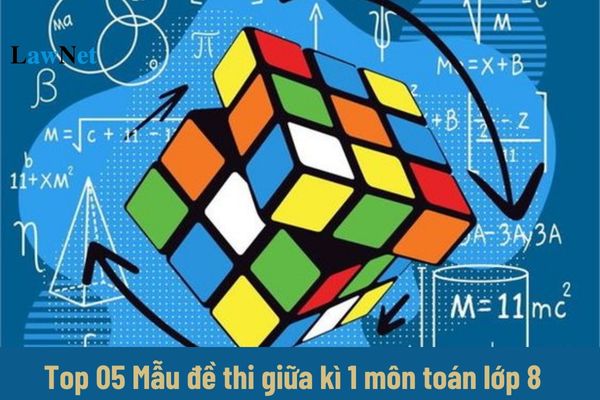Vietnam: What are the Top 05 sample 1st mid-semester question papers of 8th-grade Mathematics? What are the objectives of the Mathematics curriculum at the lower secondary level?
What are the Top 05 sample 1st mid-semester question papers of 8th-grade Mathematics in Vietnam?
The 1st mid-semester question papers of 8th-grade Mathematics selected below are the best for students to reference:
1st mid-semester question papers of 8th-grade Mathematics...download
1st mid-semester question papers of 8th-grade Mathematics...download
1st mid-semester question papers of 8th-grade Mathematics...download
1st mid-semester question papers of 8th-grade Mathematics...download
1st mid-semester question papers of 8th-grade Mathematics...download
Note: Content is for reference only!

What are the Top 05 sample 1st mid-semester question papers of 8th-grade Mathematics in Vietnam? What are the objectives of the Mathematics curriculum at the lower secondary level? (Image from Internet)
What are the characteristics of Mathematics in Vietnam?
According to the General Education Program in Mathematics promulgated with Circular 32/2018/TT-BGDDT, specific provisions are as follows:
Mathematics increasingly has many applications in life; basic mathematical knowledge and skills have helped people solve real-life problems systematically and accurately, contributing to societal development.
Mathematics in general education contributes to the formation and development of primary qualities, general capabilities, and mathematical competence for students; develops core knowledge and skills and provides opportunities for students to experience and apply mathematics in practice; establishes connections between mathematical ideas, between Mathematics and practice, between Mathematics and other educational subjects and activities, especially with Science, Natural Sciences, Physics, Chemistry, Biology, Technology, and Informatics to implement STEM education.
Mathematics content is often logical, abstract, and general. Therefore, to understand and learn Mathematics, the school Mathematics curriculum needs to ensure a balance between "learning" knowledge and "applying" knowledge to solve specific problems.
In the process of learning and applying mathematics, students always have the opportunity to use technological tools, modern teaching equipment, especially electronic computers and calculators, to support the representation, exploration, and discovery of knowledge and solving mathematical problems.
In the general education program, Mathematics is a compulsory subject from Grade 1 to Grade 12. Mathematics education content is divided into two stages:
- Basic Education Stage: Mathematics helps students systematically understand essential mathematical concepts, principles, and rules necessary for everyone, laying the foundation for studying at subsequent levels or can be used in daily life.
- Career-Oriented Education Stage: Mathematics provides students with a relatively comprehensive view of mathematics, and understand the role and applications of mathematics in practice, and related careers to form career orientations. Students can independently explore math-related issues throughout their lives. In addition to core educational content, each academic year, students (especially those aiming for natural sciences and technology) can choose to study several learning topics. These topics aim to enhance math knowledge, and skills to apply mathematics in practice, satisfying students' interests, needs, and career orientation.
The Mathematics curriculum in both educational stages has a linear structure integrated with a "concentric spiral" (concentric, expanding, and gradually enhancing), revolving around and integrating three knowledge strands: Number, Algebra, and some elements of Analysis; Geometry and Measurement; Statistics and Probability.
What are the objectives of the Mathematics curriculum at the lower secondary level in Vietnam?
According to the General Education Program for Mathematics issued with Circular 32/2018/TT-BGDDT, specific provisions are as follows:
The Mathematics curriculum at the lower secondary level aims to help students achieve the primary objectives:
- Contribute to the formation and development of mathematical competence with requirements to achieve: posing and answering questions when reasoning, solving problems, being able to make reasonable arguments when solving problems, and being able to prove mathematical propositions not too complex;
- Be able to use mathematical models (mathematical formulas, algebraic equations, diagrams, etc.) to describe situations appearing in some practical problems not too complex; use mathematical language in combination with ordinary language to express mathematical content and evidence, methods and results of reasoning; present ideas and the use of tools, means to perform a learning task or to express mathematical reasoning and justification.
- Master basic mathematical knowledge and skills in:
+ Number and Algebra: Number system (from natural numbers to real numbers); calculation and use of calculation tools; algebraic language and symbols; transforming algebraic expressions, equations, systems of equations, inequalities; using the language of functions to describe (model) some processes and phenomena in reality.
+ Geometry and Measurement: The content of Geometry and Measurement at this level includes Visual Geometry and Plane Geometry. Visual Geometry continues to provide language, symbols, and descriptions (at a visual level) of objects in reality (plane figures, solid figures);
+ Establishing some common geometric models; calculating some geometric elements; developing spatial imagination; solving some simple practical problems associated with Geometry and Measurement. Plane Geometry provides knowledge and skills (at the level of logical reasoning) about geometric relationships and some common plane figures (points, lines, rays, segments, angles, two parallel lines, triangles, quadrilaterals, circles).
+ Statistics and Probability: Collecting, classifying, representing, analyzing, and processing statistical data; analyzing statistical data through frequency, and relative frequency; recognizing some simple statistical rules in reality; using statistics to understand basic concepts of experimental probability of an event and the probability of an event; recognizing the significance of probability in practice.
- Contribute to helping students gain an initial understanding of careers related to Mathematics; be aware of career orientation based on capacity and interests, conditions, and personal circumstances; directing post-secondary school pathways (further study, continuing education).

